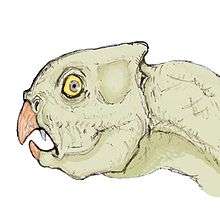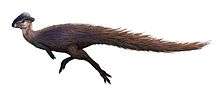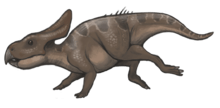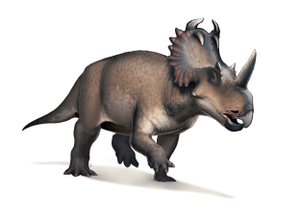Xuanhuaceratops
Xuanhuaceratops is a genus of dinosaur from the Late Jurassic Period (dated to 150.8-145.5 million years ago).[1] A member of the family Chaoyangsauridae, it was one of the earliest ceratopsians.[2][3][4] The fossils were found in the Houcheng Formation of Hebei Province, northeastern China.[4]
| Xuanhuaceratops | |
|---|---|
 | |
| Scientific classification | |
| Kingdom: | Animalia |
| Phylum: | Chordata |
| Clade: | Dinosauria |
| Order: | †Ornithischia |
| Suborder: | †Ceratopsia |
| Family: | †Chaoyangsauridae Zhao, 2006 |
| Genus: | †Xuanhuaceratops Zhao et al., 2006 |
| Type species | |
| †Xuanhuaceratops niei Zhao et al., 2006 | |
This dinosaur was described in a report in the journal Acta Geologica Sinica by Chinese paleontologist Zhao Xijin and colleagues. Xuanhuaceratops had previously been mentioned in press as "Xuanhuasaurus", a nomen nudum.
Description
Xuanhuaceratops niei is known only from four fragmentary skeletons recovered from the Houcheng Formatio of Hebei Province, China. These skeletons share a number of distinct features with a potential close relative, Chaoyangsaurus, discovered in the adjacent province of Liaoning, with the exception of several cranial formations.[4] Chief among these is the presence of an additional premaxillary tooth, although other differences in the quadrate and scapula have also been noted.
Classification
Xuanhuaceratops niei is a member of the Chaoyangsauridae, a family that is thought to represent a lineage of Ceratopsia basal to all neoceratopsians and psittacosaurids.[4] Xuanhuaceratops niei was originally known from a single, fragmentary skeleton discovered in the 1970s and mentioned by name in a 1985 study, but without a specified holotype or description, the name was considered a nomen nudum.[5] Based on morphological similarities, Zhao Xijin considered it one of three "prototype psittacosaurids"[5] along with Dianchungosaurus and Chaoyoungosaurus, which together made up the "chaoyoungosaurids".
In 2003, fossil fragments from three additional specimens were discovered by Zhao Xijin, Cheng Zhengwu, Xu Xing, and Peter J. Makovicky. However, these specimens were less complete than their predecessor, and so the original specimen was made the holotype when describing the taxon.
See also
References
- Holtz, Thomas R. Jr. (2011) Dinosaurs: The Most Complete, Up-to-Date Encyclopedia for Dinosaur Lovers of All Ages, Winter 2010 Appendix.
- Weishampel et al. (2004) "Dinosaur Distribution." In: Weishampel, D.B., Dodson, P., & Osmolska, H. (Eds.). The Dinosauria (2nd Edition). Berkeley: University of California Press. Pp. 517–606 Full text.
- Xu X., Forster, C.A., Clark, J.M., & Mo J. (2006). "A basal ceratopsian with transitional features from the Late Jurassic of northwestern China." Proceedings of the Royal Society B: Biological Sciences. doi:10.1098/rspb.2006.3566.
- Zhao, X., Cheng, Z., Xu., X., and Makovicky, P. J. 2006. "A new ceratopsian from the Upper Jurassic Houcheng Formation of Hebei, China." Acta Geologica Sinica, 80 (4): 467–473 Full text.
- Zhao Xijin, 1985. "The Jurassic Reptilia". In: Wang Si-en, Cheng Zhengqu and Wang Neiwen (eds.). The Jurassic System of China. Stratigraphy of China. Pp. 11, 286–289, 347, plates 10 and 11. http://paleoglot.org/files/Zhao%2085.pdf Full text.


